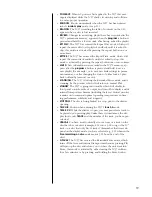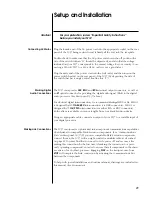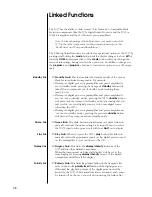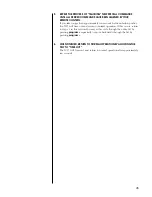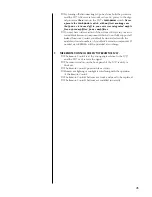
33
Programming the Nº37
Introduction to Playlists
Rather than playing an entire CD, you may choose to play only certain selections.
To do this, you create a “playlist.” If this is a one-time playlist, it may be used im-
mediately upon being created (and will vanish when a new playlist is created).
Alternatively, thousands of playlists may be stored in the Nº37’s permanent
memory, at which point each becomes the default playlist for the particular disc
with which it is associated (until you explicitly change it).
Before using your Nº37’s programming features, become familiar with its controls
and their locations, as well as their basic functions.
Note:
During the playing of a playlist, the Nº37’s basic functions
operate as described in “Basic Operation,” except that they affect
the playback of the
program
, not the entire CD. For instance, press-
ing
next
during play skips to the next track in the playlist, whether
or not it is the next track on the CD. In the same way, engaging
disc
repeat
will repeat the entire
playlist
, not the entire disc.
The Nº37 allows up to 99 selections per playlist, with any given track appearing
once only. In practical terms, the only limitation on the length of your playlist is
the number of tracks on your disc.
Important Note:
Assembling a playlist is possible only when the disc is
stopped.
The Nº37’s memory can store playlists for thousands of different CDs. Saved
playlists remain in memory when you place the Nº37 into
standby
, when you
turn off the
main power
switch — even if AC power is interrupted.
When you load a CD, the Nº37 reads its unique identification code. If you as-
semble a playlist for a particular CD
and
save it into the Nº37’s memory, the Nº37
“remembers” that CD’s playlist.
The next time you load that CD, the Nº37 will recognize the CD’s identification
code and automatically load the previously saved playlist. (The display initially
shows the number of tracks and total time on the
disc
, followed by the number
of tracks and total time of the
playlist
, preceded by the letter
P
in the display.)
Even if you have previously saved a playlist for a CD, the Nº37 allows you to tem-
porarily override it (and have access to all tracks on the CD), without erasing it
from memory. This temporary override applies to polarity programming as well
(
see p. 35
).
To temporarily override a previously saved playlist, press
program –
while the CD
is loaded but before play has started. All of the CD’s tracks will subsequently be
accessible for normal operations, but the original playlist will still be retained in
the Nº37’s memory. You can even create a temporary playlist as an alternative to
your normal, permanent playlist.

